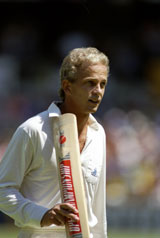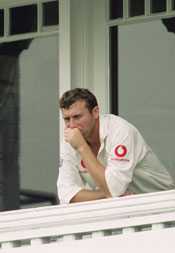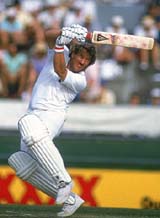Seizing the lifeline
England's approach to one-day cricket has been a shambles for years, but in recent months - just as the rest of the world gears up for the World Cup, in fact - the planning and preparation has gone into meltdown
|
|

|
England's Ashes victory in 2005 could not have been possible had it not been for their singular dominance over two key individuals - Adam Gilchrist, who didn't make a half-century all series, and Matthew Hayden, who did ... but not until the horse had all but bolted in the final match of the series. Two years earlier, Hayden had been a batsman at the peak of his powers, bullying opponents into submission with his stand-and-deliver strokeplay. At one stage he had managed 19 hundreds in 41 Tests, but by the Oval Test, he had gone 30 innings without a three-figure score, and had been badly found out by men such as Matthew Hoggard, whom he had formerly treated with disdain. Knowing that the axe was hovering above his head, he set himself to survive no matter what and in a disciplined, determined and uncharacteristically scratchy innings, made 138 of the most cathartic runs of his career. Suddenly the beast had been unleashed. He followed up with centuries in each of his next three Tests and, to judge by his 153 at Melbourne this winter, is still going strong.
Bradman, famously, was dropped from Australia's Test side just once in his incomparable career - and that happened straight after his debut. But by 1946-47, seven war-torn years had gone by since his last Test appearance and in that time Bradman had been weakened by fibrositis, the illness that forced his discharge from the Army in 1941, and distracted by his burgeoning business interests. There was no guarantee that he would see out the summer, as England toured to reignite the Ashes. Had he been given out on 28, however, when he edged Bill Voce to second slip where Jack Ikin thought he had taken a clean catch, that could quite conceivably have been that. Instead Bradman ploughed onwards and upwards, finishing with 187 - his 22nd Test century in his 38th Test - and an innings-and-332-run win.
|
|

|
Australian legends don't always get the sort of cap-doffing treatment that came Shane Warne's way this winter. On England's last tour of Australia in 2002-03, their captain, Steve Waugh, was coming under mounting pressure for his lack of runs and advancing age. He had guided Australia to a 4-0 series lead with one match to play, but in his last 23 Test innings he had posted just four fifties and one century. Another failure and the axe was almost certain to fall, especially as Ricky Ponting was already in charge of the one-day side that was about to begin a triumphant World Cup campaign. In the build-up to the match the career obituarists were already in full flow, with one journalist asking Waugh what the highlight of his career had been. "It might be yet to come," came the prophetic reply. With his side in rare trouble at 150 for 5, Waugh accumulated grimly in partnership with Adam Gilchrist, until he was left needing two runs for his century from the final delivery of the second day. Cool as a cucumber, he lashed Richard Dawson through the covers to cue an outpouring of sentiment from a rapt nation.
If Atherton and Waugh thought they had it bad, then few form slumps can have been so prolonged or destabilising as the one that engulfed Mark Taylor in the run-up to the 1997 Ashes. For eighteen months he could barely buy a run, and it was only the acknowledged excellence of his captaincy and the good-humoured diplomacy he brought to the job that kept the knives from his back. But then things turned nasty for him and his team. A unexpected whitewashing in the Texaco Trophy against a resurgent England was followed by a humiliating first morning of the Ashes at Edgbaston, as Australia were rolled over for 118, having at once stage been 54 for 8. Taylor's own share was 7, making it 11 Tests and 21 innings since he had last made even a half-century. When England bulldozed their way to 478 for 9 declared in reply, Taylor knew he would be getting no final final chances. In 396 minutes of the gutsiest batting imaginable, Australia's captain hauled his career back from the brink with his 15th Test century. It didn't save the Test, but it ultimately turned the series.
It was Botham's Match, of that there is no doubt. But the coup de grace of arguably the most famous game of all time was delivered by a man on whom time had already been called by the selectors. Bob Willis's inspired spell of 8 for 43 scattered the Aussies for 111 and made possible England's successful defence of the Ashes, but he had originally been omitted from the squad in favour of the Derbyshire seamer, Mike Hendrick. England's returning captain, Mike Brearley, believed Willis - who by now was 32 and increasingly fragile - had a chest infection that would rule him out of contention for the Test. Willis, however, argued otherwise, and to prove his fitness was asked to bowl flat out in a 40-over one-day game for Warwickshire, as well as a second-XI match and an extended net session. "Hendrick's invitation to play was intercepted before it could reach him," Willis explained. "My name was among those read out to the waiting world on the midday news the following day."
Ashington's third most famous sporting son is also one of the most notoriously reluctant travellers ever to play international cricket. His first England tour, to Pakistan with the Under-19s in 1996-97, ended in an early flight home and the lifelong friendship of his captain on that trip, Andrew Flintoff. His first Ashes tour, in 2002-03, degenerated into an attack of the yips when he lost his run-up at Perth, and the following winter, he was sent home from the tour of Bangladesh after taking nine wickets in the first Test. Ostensibly he had suffered a back injury on the flight from Dhaka to Chittagong, but when he wasn't invited back for the Sri Lankan leg of the tour, murmurs started to circulate about his attitude. He returned under something of a cloud for the tour of the Caribbean in April, whereupon he stunned the world - and himself - with 7 for 12 in the first Test in Jamaica. Before long he was an equally reluctant No. 1 in the world rankings.
In Australia they heave under-achieving legends out of the side window; in South Africa they plot how to ensure they can bow out with dignity. Last year that was what Shaun Pollock's career had been reduced to. In 12 Tests since the start of 2005 he had mustered just 29 wickets at 43.17, more than double his previous career average, and it seemed it was only his batting that was keeping him in the side as Makhaya Ntini and Andre Nel shared the new-ball burden. And with just two fifties to his name in that period, even that was debatable. But then along came India, and a remarkable rebirth took place. His 13 wickets came at just 16 runs apiece and with the bat he delivered a pair of matchwinning performances at Durban and Cape Town, the last of which came after being shoved up to No. 4 in the order. "I'm not the first Pollock to bat at No.4 for South Africa," he said while accepting his Man-of-the-Series award, in reference to his famous uncle, Graeme.
If Raymond Illingworth had had his way, Alec Stewart's mighty England career would have been sawn off shortly after his half-century. Following a disappointing tour of South Africa (and an even worse World Cup), Stewart was one of a clutch of scapegoats that included Robin Smith and Angus Fraser, as England began their next Test series against India in 1996. Stewart by this stage had played 53 Tests at an average of 38.23, not too shabby by the dismal standards of England's decade, but he was ousted in favour of Nick Knight. Knight, however, broke a finger during his comeback Test, and a suitably piqued Gaffer resumed his duties for the second Test on his favourite ground, Lord's. He made 66 in the second innings to secure the draw, and then embarked on a run of form that included at least a half-century in his next nine games. By that winter he had even been reunited with the wicketkeeping gloves, and responded with innings of 101 not out and 173 against Zimbabwe and New Zealand.
Andrew Miller is UK editor of Cricinfo
